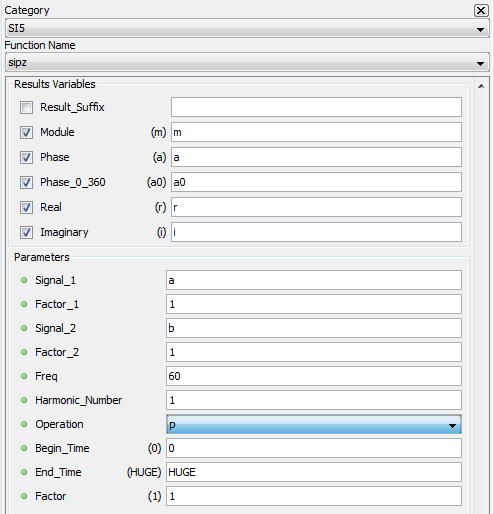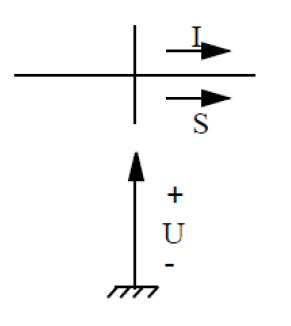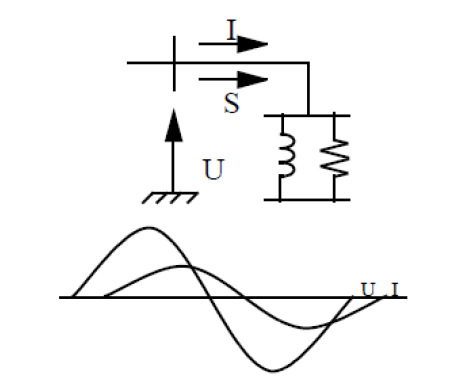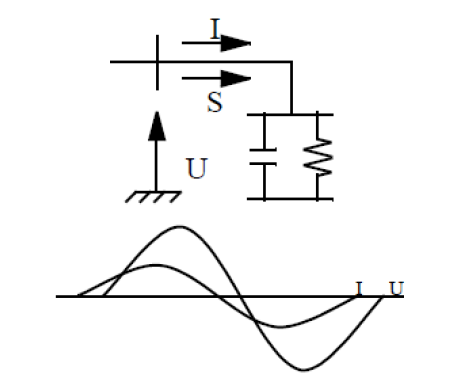Documentation Home Page ◇ HYPERSIM Home Page
Pour la documentation en FRANÇAIS, utilisez l'outil de traduction de votre navigateur Chrome, Edge ou Safari. Voir un exemple.
Advanced | SIPZ
POWER AND IMPEDANCE – [SIPZ]
Compute the power, impedance, addition or subtraction of two signals for a given harmonic.
CATEGORY
Advanced
DESCRIPTION
This function allows to compute the power, impedance, addition or subtraction of two signals for a given harmonic.
RESULT VARIABLES AND PARAMETERS
| Module (m) | Module (or amplitude) resulting from the operation specified for the harmonic multiplied by the absolute value of the factor. |
| Phase (a) | Angle a (or phase) resulting from the operation specified for the harmonic. Value is between -180 and 180 degrees [°]. Since the module is multiplied by the absolute value of the factor, the phase is modified if the multiplying factor is negative. In this case, 180 degrees are added to the phase. |
| Phase 0-360 (a0) | Angle a0 (or phase) resulting from the operation specified for the harmonic. Value is between 0 and 360 degrees [°]. |
| Real (r) | Real part r of the module and angle computed (m * cos(a)). |
| Imaginary (i) | Imaginary part i of the module and angle computed (m * cos(a)). (m * sin(a)). |
| Signal_1 | First signal to analyze (voltage signal). |
| Factor_1 | Multiplying factor to use for all samples of signal 1. |
| Signal_2 | Second signal to analyze (current signal). |
| Factor_2 | Multiplying factor to use for all samples of signal 2. |
| Freq | Fundamental frequency of the signals in Hertz [Hz], normally computed with the sifreq function. |
| Harmonic number | Number of harmonic to compute.
|
| Operation | Operation to execute on the modules (or amplitudes) and angles of the required harmonic for each input signal. The modules and angles are first computed on the two input signals and then the specified operation is applied to these modules and angles. The defined operators are :
|
| Begin_time | Time at which the analysis of a signal must start. This time is expressed in milliseconds [ms]. This value must be greater than 0 and lower than the duration of the test. The default value is 0. |
| End_time |
The begin_time and end_time specified for the calculation of the harmonics must be the same as those used in the sifreq sequences to compute the fundamental frequency. |
| Factor | Multiplying factor for the results generated by the function. The default value of the multiplying factor is 1.0 and has no effect on the results. |
SYNTAX
[m, a, a0, r, i] = sipz(a, 1, b, 1, 60, 1, "p", 0, HUGE, 1)
CHARACTERISTICS
Data type support
Double Floating point
EXAMPLE
The first diagram shows how to compute the different powers (p): apparent, active and reactive.
This function computes the apparent, active and reactive powers. For accurate calculations, voltage signals must be specified on the Signals1 line and current signals on the Signals2 line of the form.
The signs produced are based on the se-
| S | Apparent power (complex) |
|---|---|
| P | Active power |
| Q | Reactive power |
| S | P+jQ |
|
|
|
|
|
|
The following diagram shows how to compute the different impedances (/): complex, resistance and reactance.
| S | Complex impedance |
|---|---|
| P | Resistance |
| Q | Reactance |
| S | P+jQ |
The resistance is equal to the real part (r) of the complex impedance.
|
|
|
|
Finally, the next diagram shows the different formulas used with the operations allowed: power (p), impedance (/), addition (+), subtraction (-) and multiplication (*).
Let:
| m1 | module of signal 1 |
|---|---|
| m2 | module of signal 2 |
| a1 | angle of signal 1 |
| a2 | angle of signal 2 |
Addition:
|
|
|
|
Subtraction:
|
|
|
|
Multiplication:
|
|
|
|
Impedance
|
|
|
|
Power (p)
|
|
|
|
OPAL-RT TECHNOLOGIES, Inc. | 1751, rue Richardson, bureau 1060 | Montréal, Québec Canada H3K 1G6 | opal-rt.com | +1 514-935-2323
Follow OPAL-RT: LinkedIn | Facebook | YouTube | X/Twitter



